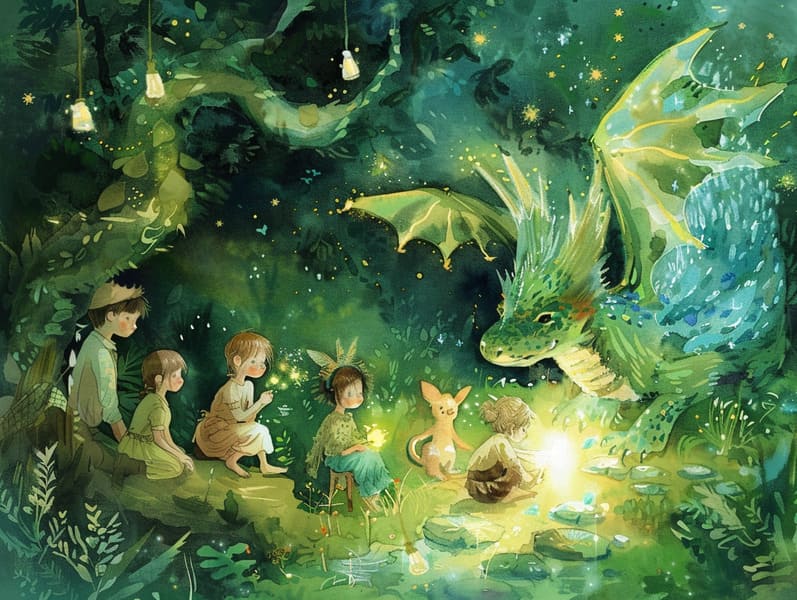The Emergence of Historical Fairy Tales with the Continued Grandeur.
The Emergence of Historical Fairy Tales with the Continued Grandeur.
Blog Article

Famous fairy tales have timeless appeal. These stories have been recounted from one generation to the next centuries before they were ever documented. They developed from a variety of societies, including European traditions. They were initially disseminated among adults, often carrying themes and messages relevant to the societal norms and beliefs of the time.
The Grimm brothers, Jacob and Wilhelm Grimm, were among the first to compile and publish many of these beloved narratives. Their collection, "Grimm's Children's Stories," included tales like "Ashenputtel," "Hansel and Grethel," and "The True Story of Snow White," which have since become essentials in the world of beloved fairy tales. Similarly, H. C. Andersen's fanciful tales, such as "The Little Mermaid," and "The Little Duckling," have captivated hearts worldwide, ensuring their place in the pantheon of classic fairy tales.
Despite being ancient, classic fairy tales remain as important as ever, especially as children's bedtime stories. These delightful tales are now available in numerous formats, including artistically illustrated books, enchanting animations, and web-based fairy tales.
Their ongoing significance can be traced to several delightful features:
Vital Lessons: Traditional fairy tales often whisper important moral lessons. Narratives like "The Shepherd Boy and the Wolf" teach the merit of being truthful, while "The Race of the Tortoise and the Hare" exemplify the qualities of tenacity and humility. These narratives offer the young clear distinctions between correct and incorrect, helping to shape their moral compass in a gentle yet lasting way.
Sympathy and Perception: Traditional fairy tales frequently depict protagonists facing struggles and tests, urging young readers to understand with their struggles and root for their triumphs. For instance, "The Story of Beauty and the Beast" illustrates the benefit of seeing inner beauty to understand the true being of a character, encouraging compassion and perception.
Cultural Awareness: Many old fairy tales are deeply embedded in the cultural contexts from which they arose. Delving into these tales can provide delightful insights into different historical contexts, encouraging a sense of global insight and recognition.
Inventiveness and Imagination: The fantasy-filled elements in fairy tales—talking beasts—invigorate children’s creative minds. These narratives lead readers to fantasy realms, activating inventive thinking and a sense of mystery that persists a lifetime.
Timeless fairy tales are not only fantastical but also pedagogical. They serve as fantastical tools in building various cognitive and affective skills in children. When fairy tales are narrated, they develop language development by introducing new language items and sophisticated sentence structures. This practice also cultivates listening skills and attention, as young readers listen intently, ready to see what happens next.
Furthermore, examining the themes and characters of traditional fairy tales can strengthen analytical skills and logical thinking. Children are led to identify patterns, anticipate outcomes, and get cause and effect. These explorations also promote children convey their thoughts and feelings, boosting their emotional intelligence.
In today’s electronic age, the availability of digital fairy tales has made these fairy tales more acquirable than ever. Online platforms and software supply large libraries of timeless fairy tales that can be viewed or listened to anytime, anywhere. Fairy tales voiced are particularly prevalent, supplying an captivating way for young ones to enjoy these fascinating tales. Sound books and voiced videos transport characters and settings to life, often supported by charming music and soundtracks that intensify the storytelling journey.
The enduring charm of old fairy tales lies in their ability to adapt to contemporary times while keeping their fundamental ideas. Contemporary takes of these narratives often include more inclusive protagonists and modern settings, making them familiar to today’s audience. However, the underlying themes of guts, goodness, and impartiality remain unchanged, continuing to touch children of all ages.
Classic fairy tales also offer a sense of contentment and homeliness. They impart a structured narrative with a straightforward beginning, middle, and end, often closing with the solving of conflicts and the triumph of virtue over vice. This assuredness can be easing for young readers, distributing a sense of constancy in an always shifting world.
Traditional fairy tales continue to entrance and edify new generations, maintaining their majesty and significance in modern society. As nighttime stories for kids, they share a perfect blend of fantasy and learning, boosting moral values, empathy, and creativity. The prevalence of internet fairy tales and the commonness of fairy tales read out loud certify that these traditional stories remain accessible to new generations.
By upholding and circulating these narratives, we continue to acknowledge the rich tapestry of fables and cultural heritage. Whether you are discovering a vividly illustrated book, discovering a internet library, or hearing an spoken story, the charm of popular fairy tales is always within reach. These tales illustrate of the everlasting effect of storytelling and its ability to link us across eras and regions.
Be it you are enjoying a richly illustrated book, discovering a digital collection, or listening through an audiobook, the spell of bedtime fairy tales is always check it out within reach.
These narratives highlight of the persistent influence of storytelling and its ability to unite us across eras and regions, weaving a spell that delights and instructs alike.